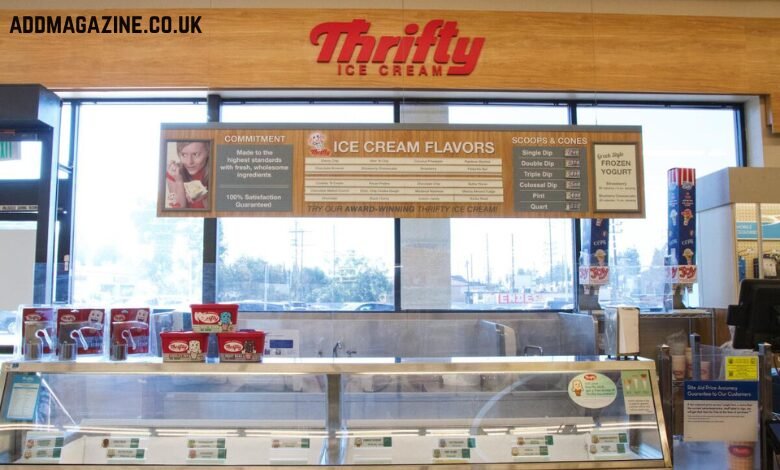In the ever-changing landscape of business, companies are faced with countless challenges, some of which are beyond their control. Often, the term “collateral damage” is used to describe situations where good businesses and loyal customers are negatively impacted due to circumstances they didn’t cause. In this case, a significant player in the ice cream world is finding itself in the midst of such collateral damage, as a result of a bankruptcy filing. Thrifty Ice Cream, a beloved brand that has been around for decades, is shutting down about 500 of its locations, all due to Rite Aid’s bankruptcy. What does this closure mean for the company, its employees, and the loyal customers who have frequented these locations for years? This article dives into the reasons behind the closures, the history of Thrifty Ice Cream, and what could potentially happen to the brand moving forward.
The Impact of Bankruptcy
Rite Aid’s bankruptcy filing is a direct reason for the closure of the 500 Thrifty Ice Cream locations. However, the fallout from bankruptcy often reaches far beyond the initial cause. The company has been struggling financially, and part of its Chapter 11 filing includes the closure of these ice cream counters. But what exactly does this mean for the future of the ice cream brand, its employees, and its customers?
Bankruptcy is not an unusual event in the business world. It happens when a company is no longer able to meet its financial obligations and needs to restructure its operations to keep going. Rite Aid, a major player in the pharmacy industry, had been dealing with significant losses for some time, and their bankruptcy is a measure to help address this financial burden. Unfortunately, some businesses and assets are collateral damage in the process, and in this case, the 500 Thrifty Ice Cream locations are casualties of this restructuring.
The History of Thrifty Ice Cream

Thrifty Ice Cream’s story dates back to 1940, when it was first introduced at a small factory in West Hollywood, California. The product quickly became a hit, drawing customers from all over Los Angeles to the flagship Thrifty Drug Store downtown. Known for its high-quality, small-batch production, Thrifty Ice Cream garnered significant attention, even earning awards at the L.A. County Fair. Over time, the brand became iconic on the West Coast, with numerous celebrity endorsements and a loyal following.
By the 1970s, Thrifty Ice Cream had reached cult status, with people lining up for scoops of their favorite flavors. One of the things that set Thrifty apart was its patented square scoop, which offered a unique way to enjoy the ice cream. It wasn’t just the flavor that was memorable, but also the experience of eating it.
Despite its humble beginnings and regional success, Thrifty Ice Cream’s continued growth and popularity eventually attracted the attention of Rite Aid, a major pharmacy chain. In the 1990s, Rite Aid acquired the brand, and it became a fixture inside their stores. Thrifty Ice Cream counters inside Rite Aid pharmacies allowed customers to enjoy a scoop of nostalgia while shopping for their health and wellness needs. For many people, a visit to Rite Aid was incomplete without stopping by the ice cream counter.
A Growing Problem: Rite Aid’s Financial Struggles
While Thrifty Ice Cream may have once been a beacon of sweet treats, its fate has become entwined with the financial struggles of Rite Aid. The company’s bankruptcy filing was a result of a long history of financial difficulties, which were exacerbated by the economic impacts of the COVID-19 pandemic. As the world shifted to remote work and online shopping, many brick-and-mortar stores, including pharmacies, saw a significant decline in foot traffic.
Rite Aid, which once thrived on in-person visits to pick up prescriptions and other necessities, found itself facing new challenges. As people stayed home and avoided crowded spaces, pharmacies and convenience stores that relied on daily foot traffic began to feel the effects. With fewer customers walking through their doors, Rite Aid was left with mounting debts and fewer ways to generate revenue.
Rite Aid’s bankruptcy filing allowed the company to restructure its operations and eliminate unprofitable assets. Unfortunately for Thrifty Ice Cream fans, the 500 ice cream counters inside Rite Aid stores were part of those unprofitable assets. Since the ice cream counters are embedded within the pharmacies, they could not be sold as a separate entity, further complicating the situation.
The Fate of Thrifty Ice Cream

With the closure of these 500 ice cream counters, Thrifty Ice Cream faces an uncertain future. The brand will still be available in the freezer sections of various retailers, such as Albertsons, Vons, and Rite Aid itself, as well as in certain scoop counters across California, Arizona, and other regions. However, the 500 locations inside Rite Aid pharmacies were crucial to the brand’s visibility and sales. These counters served as an important touchpoint for customers who may not have otherwise bought Thrifty Ice Cream in the frozen food aisle.
One of the challenges facing Thrifty Ice Cream now is the uncertainty surrounding its future ownership. As part of Rite Aid’s Chapter 11 bankruptcy sale, the company’s assets, including Thrifty Ice Cream, will be sold to the highest bidder. The question is: will anyone step forward to purchase the brand?
Thrifty Ice Cream could potentially be sold to another company that wants to continue operating it as a standalone business. This could include producing and selling ice cream in grocery stores or continuing to supply the ice cream counters in non-Rite Aid locations. It’s also possible that a buyer could purchase the factory and repurpose it for other uses, leaving the brand itself to fade into history.
If no buyer emerges, the brand could cease to exist altogether, a sad end to a long and storied legacy.
The Legacy of Thrifty Ice Cream
Thrifty Ice Cream is more than just a brand; it’s a part of the history of Southern California and the broader West Coast. It has served as a nostalgic symbol for generations of ice cream lovers. The square scoops, the inventive flavors, and the hand-crafted cartons all contribute to the unique identity of the brand.
Beyond its delicious flavors, Thrifty Ice Cream has become a symbol of the changing retail landscape. The fact that its closure is linked to the bankruptcy of Rite Aid highlights the vulnerability of businesses that once seemed invincible. Even brands with deep-rooted histories can fall victim to shifting consumer behaviors and economic disruptions. The closure of these 500 locations is a painful reminder of how quickly the retail world can change.
Conclusion: A Bitter End
The bankruptcy of Rite Aid and the subsequent closure of 500 Thrifty Ice Cream locations are a bittersweet chapter in the history of this beloved ice cream brand. While it’s not the fault of Thrifty Ice Cream that these stores are closing, the collateral damage is undeniable. Loyal customers will no longer be able to visit their local Rite Aid for a scoop of Thrifty Ice Cream, and employees who worked at these locations are left without jobs.
Despite the uncertainty, there is still hope that the brand could survive. A new owner could continue to operate Thrifty Ice Cream, ensuring that it remains a staple in the ice cream world. However, with each passing day, the brand’s future seems more uncertain. The fate of Thrifty Ice Cream serves as a reminder of the delicate nature of businesses in today’s economy, and the unforeseen consequences that can arise when companies face financial struggles.
FAQs
1. Why is Thrifty Ice Cream closing 500 locations?
Thrifty Ice Cream is closing 500 locations due to Rite Aid’s bankruptcy filing, which involves restructuring and asset elimination.
2. Can Thrifty Ice Cream still be purchased after the closures?
Yes, Thrifty Ice Cream will still be available in the freezer section of stores like Rite Aid, Albertsons, and Vons.
3. What happened to the employees at the closed locations?
Employees at the closed Thrifty Ice Cream counters are likely affected by the Rite Aid bankruptcy, with some losing jobs.
4. Will someone buy the Thrifty Ice Cream brand?
The Thrifty Ice Cream brand could potentially be sold as part of Rite Aid’s Chapter 11 bankruptcy proceedings, but it’s uncertain.
5. When did Thrifty Ice Cream first become popular?
Thrifty Ice Cream gained popularity in the 1940s and became a staple on the West Coast, known for its unique flavors.




